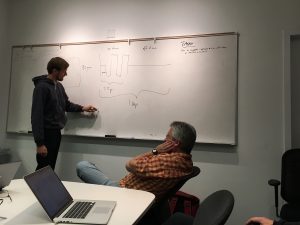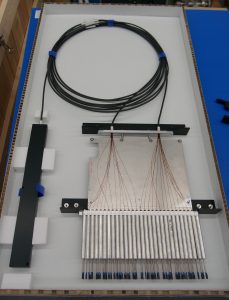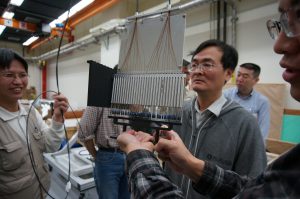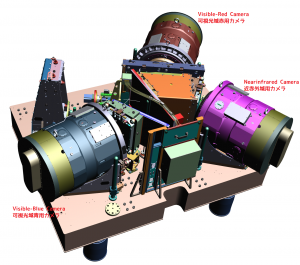PFS instrument catches light from about 2400 astronomical objects using fibers paved on the focal plane at the prime focus of the Subaru telescope, and each fiber is positioned by 2-staged actuator called “Cobra” ( ). As talked in the previous posts, 57 assemblies of Cobra positioners and fibers are integrated to one module, which is mounted to the optical bench. Since mass production of fiber positioners started early this year, the integration of the first module has been in progress at Caltech, the US, where engineers from Caltech and NASA/JPL who expert on positioners, and those from LNA (Laboratório Nacional de Astrofísica, Brazil) in charge of fiber parts, are working together.
). As talked in the previous posts, 57 assemblies of Cobra positioners and fibers are integrated to one module, which is mounted to the optical bench. Since mass production of fiber positioners started early this year, the integration of the first module has been in progress at Caltech, the US, where engineers from Caltech and NASA/JPL who expert on positioners, and those from LNA (Laboratório Nacional de Astrofísica, Brazil) in charge of fiber parts, are working together.
In this article, we will talk about assembly of Cobra module, spotlighting positioners.
A module has 2 lines of Cobra positioners controlled using 2 electronic board. In the below video, 28 positioners in one line are moved simultaneously using one board. The fibers will be assembled in the future.
In parallel with development of the first Cobra module, the software to control positioners has been developed by team from NASA/JPL (Jet Propulsion Laboratory). To cover entire field of view, each fiber patrol area, where a fiber moves around, overlaps slightly with neighboring fibers. Hence, their collision potentially happens. The software is being developed following discussions how to move positioners to reduce the possibility of collision, and how to calibrate positioners to converge them to a target position well. Simulations of collisions has also been carried out.

[ Discussion on strategy of Cobra calibration. From left: Dr. Johannes Gross (Engineer, NASA/JPL), Dr. Daniel Reiley (Engineer, Caltech) ]
Completed modules will be shipped to ASIAA (Academia Sinica, Institute of Astronomy and Astrophysics) in Taiwan, where the modules will be mounted to the optical bench, and about 8-meter long fibers will be routed inside of main structure. Because of tight spacing, devoting great care is needed to integration work not to damage the instruments. Therefore, ASIAA team have made full-size mock-ups to practice the assembly.
 [ Mock-up of Cobra module (full-scale) ]
[ Mock-up of Cobra module (full-scale) ]

[ Demonstration of assembly of Cobra modules by ASIAA team. A guide rail is used for mount. From left, Mr. Hsin-Yo, Chen (Engineer), Mr. Yin-Chang Chang (Engineer), and Prof. Shiang-Yu Wang ]
PFSはすばる望遠鏡の主焦点面に敷き詰められた約2400本のファイバーを使って広い視野内の天体を観測しますが、個々のファイバーは『コブラ』と呼ばれる2段式のアクチュエータ( )を用いて動かされます。以前紹介したように、ファイバーとアクチュエータはひとつの部品に組み立てられ、更にこの部品57個を1組のモジュールに組み上げてから、光学ベンチに取り付けられます。アクチュエータの大量生産が今年の初頭から始まって以来、最初のモジュールの組み立てがカリフォルニア工科大学(カルテク)で進行しています。ここでは、アクチュエータを担当するカルテクとNASAジェット推進所のチームと、ファイバーを担当するブラジル国立天文台(LNA)のチームが協力してモジュールを製作しています。
)を用いて動かされます。以前紹介したように、ファイバーとアクチュエータはひとつの部品に組み立てられ、更にこの部品57個を1組のモジュールに組み上げてから、光学ベンチに取り付けられます。アクチュエータの大量生産が今年の初頭から始まって以来、最初のモジュールの組み立てがカリフォルニア工科大学(カルテク)で進行しています。ここでは、アクチュエータを担当するカルテクとNASAジェット推進所のチームと、ファイバーを担当するブラジル国立天文台(LNA)のチームが協力してモジュールを製作しています。
今回はアクチュエータに注目して記事を紹介します。
ひとつのモジュールにはアクチュエータが2列に並んでおり、これらのアクチュエータは2枚の電子回路を用いて1列ずつ制御されます。以下の動画では1列分(28個)のアクチュエータを同時に動かしています。今後はアクチュエータにファイバーが取り付けられていきます。
また、コブラモジュールの組み立てと並行して、アクチュエータを駆動するソフトの開発も進行中です。ソフトウェアはNASAジェット推進研究所(JPL)のチームが開発しています。視野内にある天体を隈なく観測できるように、個々のファイバーが動くことのできる『パトロール領域』は隣り合うファイバー同士で僅かに重なり合っています。その為、場合によってはファイバー同士が衝突する可能性がありますが、どのようにアクチュエータを動かせば衝突の確率を下げることができるか、また、アクチュエータが目標位置に効率よく収束するにはどのように較正を行うべきかなどの議論を積み重ねながら開発を進めています。また、アクチュエータの動きをシミュレーションし、衝突の傾向と対策を調べたりもしています。

(左から:『コブラ』のソフトウェアについて議論を行うNASAジェット推進所のヨハネス・グロス職員とカリフォルニア工科大学のダン・レイリー職員)
完成したコブラモジュールは、主焦点装置の統合・試験を担当している台湾のASIAAに輸送され、光学ベンチへ取り付けられ、ファイバーを装置の内部に取りまわしていきます。このとき、約8mあるファイバーを、ファイバーや他の部分を傷付けない様に気を付けながら狭い主焦点装置内に組み上げていかなければいけません。その為、ASIAAでは実寸大の模型を作り、組み付けの練習をしています。

(コブラモジュールの組み付けの練習の様子。まっすぐ組み立てるためにガイドを使う。左から:中央研究院天文及天文物理研究所の陳心躍 (チェン シンヨウ) 技術職員、張蔭昌 (チョウ インチャン)技術職員、王祥宇 (ワン シャンユー) 教授)



